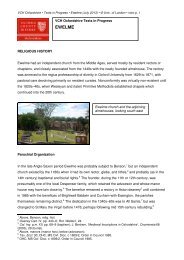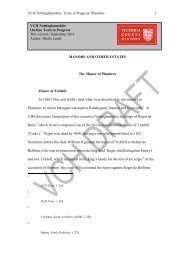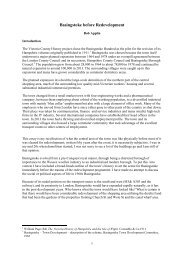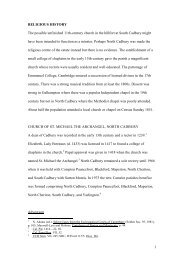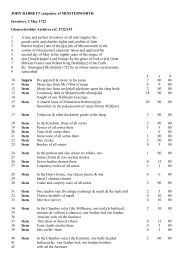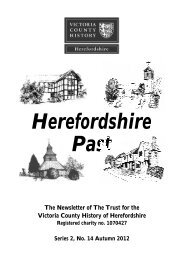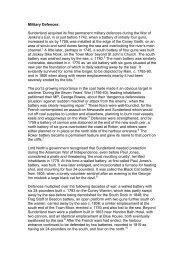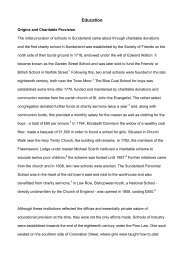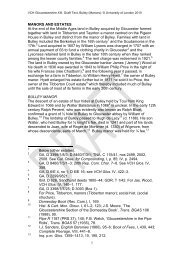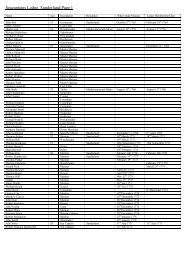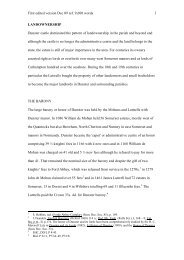Queen Camel Manors and Estates - Victoria County History
Queen Camel Manors and Estates - Victoria County History
Queen Camel Manors and Estates - Victoria County History
Create successful ePaper yourself
Turn your PDF publications into a flip-book with our unique Google optimized e-Paper software.
In 1276 the king granted it to <strong>Queen</strong> Eleanor of Castile (d. 1290) for life xv <strong>and</strong> to hissecond wife, Margaret of France (d. 1317) in 1299. xvi In 1319 Edward II granted the manor tohis brother Edmund of Woodstock, xvii executed in 1330, whose widow received his crops butwhose forfeited estates were given to William Montagu. xviii William (d. 1344) was said tohold <strong>Camel</strong> only during the minority of Edmund‟s heir. xix Edmund‟s second son, John, earl ofKent came of age in 1351 but died childless in 1352 when the manor was granted to hiswidow Elizabeth (d. 1411). xx Her great nephew Thomas Hol<strong>and</strong>, earl of Kent <strong>and</strong> duke ofSurrey (d. 1400) stored goods at <strong>Queen</strong> <strong>Camel</strong>. xxiElizabeth‟s five heirs were the sisters of Thomas Hol<strong>and</strong> or their issue. xxii <strong>Queen</strong><strong>Camel</strong> was assigned to the third sister Margaret (d. 1439), widow of John Beaufort, earl ofSomerset <strong>and</strong> later wife of Thomas of Lancaster, duke of Clarence. xxiii Margaret‟s son JohnBeaufort, duke of Somerset (d. 1444) was succeeded by his infant daughter Margaret, xxiv latercountess of Richmond (d. 1509) whose heir was her gr<strong>and</strong>son Henry VIII. xxv St John‟s <strong>and</strong>Christ‟s Colleges, Cambridge, claimed it unsuccessfully from Margaret‟s trustees as part oftheir respective endowments. xxvi The king granted <strong>Queen</strong> <strong>Camel</strong> in 1537 to Sir WilliamFitzwilliam, later earl of Southampton (d. s.p. 1542) xxvii but Hazlegrove was let in 1508 toWilliam Morris <strong>and</strong> to John Smith in 1557, other demesne l<strong>and</strong> to William Hodges in 1548,<strong>and</strong> the park to Sir William Sackville in 1552. xxviiiIn 1558 Philip <strong>and</strong> Mary sold the manor to Sir Walter Mildmay to hold for 1/40 of afee. xxix Sir Walter (d. 1589) was followed by his second son Sir Humphrey (d. 1613) <strong>and</strong>Humphrey‟s son, Humphrey (d. 1672) who was fined £1,840 in 1648 for supporting the king.The fine was remitted for supplying Holy Isl<strong>and</strong> <strong>and</strong> his estate was restored in 1649 xxx buthad been settled in 1647 on his second son Humphrey, partly to provide for his daughterCelia. The younger Humphrey resided at Hazlegrove, xxxi which in 1662 he settled on hismarriage to Sarah Parker. xxxii By c.1681 they had separated for his adultery <strong>and</strong> Sarah began
divorce proceedings for cruelty. In 1685 she was awarded the manor rents. xxxiii In 1689Humphrey (d. s.p. 1690) chose as his heir Carew Hervey Mildmay of Marks, Hornchurch,Essex, descendant of William Mildmay an older brother of Sir Walter (d. 1589). xxxiv In 1691Sarah, then of Westminster, leased her life interest to Carew who mortgaged it heavily. xxxvCarew Hervey Mildmay (d. 1743) left a son Carew (d. s.p. 1784) who made Anne,daughter of his brother Humphrey (d. 1761), his heir. In 1786 Anne (d. 1796) released thedemesnes to her niece Jane, daughter of Carew Mildmay (d. 1768), on her marriage to SirHenry Paulet St John who took the name Mildmay in 1790. xxxvi Jane (d. 1857) was followedin turn by her gr<strong>and</strong>sons Paulet (d. 1858), Hervey (d. 1882), <strong>and</strong> the Revd Charles Arundell,sons of her second son Paulet (d. 1845) who gave Dogmersfield, Hants to his elder brother inexchange for the right to inherit <strong>Queen</strong> <strong>Camel</strong>. xxxvii Wyndham Mildmay (d. 1934) son ofCharles (d. 1904) was mentally ill <strong>and</strong> his brother George (d. s.p. 1931) held the manor.George sold the estate but acquired Townsend in the village for hunting <strong>and</strong> renamed it<strong>Queen</strong> <strong>Camel</strong> House. xxxviii In 1929 lordship passed to the new owner of Hazlegrove House,Major Stern, but was not recorded in the 1935 sale <strong>and</strong> in 1939 was claimed by Mrs K. M.Wilson. It was not recorded again <strong>and</strong> presumably remains with her heirs. xxxixManor HouseIn 1229 the king ordered a hall <strong>and</strong> chamber to be built at <strong>Camel</strong> <strong>and</strong> granted timber for workon his house, which cost over £163. xl In 1400 the house was said to contain only salt fish, oldarmour, <strong>and</strong> weapons of little value <strong>and</strong> not the luxury goods worth £1,000 from a ship atRooksmill as claimed. xli In 1508—9 only a grange, dovecot, <strong>and</strong> bartons were recorded, xlii themain demesne house was Hazlegrove farm, <strong>and</strong> the old house, described in the 18th centuryas having been a palace called the Court, had probably been demolished. xliii Court Close,adjoining the churchyard <strong>and</strong> with no buildings c.1610, xliv <strong>and</strong> Pigeon House Mead may be
the site of the manor house <strong>and</strong> dovecot. xlv Foundations of a house were said to have beenfound but there is no evidence to support Gerard‟s statement that there was a park there. xlviCulverhay, with dovecot <strong>and</strong> a house built c.1593 xlvii was last recorded in 1652 xlviii but in1841 a cottage near the mill was called Pigeon House. xlixHazlegrove HouseHazlegrove farm, described as a demesne grange in 1536, l was occupied by the demesnefarmers including William Morris, his widow <strong>and</strong> her second husb<strong>and</strong> John Smith (d. 1558),John‟s son William, William‟s wife Mary Sanford <strong>and</strong> her second husb<strong>and</strong> John Warre. li In1561 Hazlegrove was a modest house with hall, parlour <strong>and</strong> chamber on the ground floor,chambers over the hall <strong>and</strong> parlour, maid‟s <strong>and</strong> men‟s chambers, <strong>and</strong> a large, possiblydetached, kitchen with cheeseroom. That matches a drawing of 1573, which shows a threestorey,two or three bay house with a massive chimney or wing flanked by door <strong>and</strong> windows<strong>and</strong> a smaller gable end chimney. A detached building to the west, linked to the house by awall, has a large upper window or louver. liiThe Mildmays rarely visited <strong>Queen</strong> <strong>Camel</strong> before the mid 17th century. HenryHebdich lived there from 1593 <strong>and</strong> the Rose family until the 1630s or later. liii By 1652 therewere both farm <strong>and</strong> mansion houses on the site <strong>and</strong> the younger Humphrey Mildmay residedin the latter. liv Carew Hervey Mildmay in 1713 had a coach way from Sparkford near the innthere probably to the coach house, reserved with the mansion from a lease of Hazlegrove in1719. lv He largely rebuilt the house in the 1730s <strong>and</strong> tax was paid on 94 windows in 1789. lviCarew <strong>and</strong> his son resided for short periods but also had houses in Sherborne <strong>and</strong> London aswell as Marks in Essex, demolished 1808. lvii Their successors were non-resident <strong>and</strong> thehouse was let furnished to Elizabeth (d. 1791), dowager countess of Glasgow <strong>and</strong> in 1793 toElizabeth Acl<strong>and</strong> (d. 1807). lviii John Armstrong held it with 51 a. of grounds in the early 19th
century. lix In 1827 Paulet, second son of Lady Jane StJohn Mildmay brought his family tolive at Hazlegrove. lx Paulet (d. 1845) <strong>and</strong> his second son Hervey (1882) were responsible formajor alterations to the house <strong>and</strong> grounds including the demolition of the farm, which hadstood next to the mansion house. By c.1881 the three-storey house included basement cellars,a billiard room <strong>and</strong> a 12-bedroom top floor. lxiAfter 1845 the house was let out again except between 1886 <strong>and</strong> 1893. Tenantsincluded Mrs Strangways <strong>and</strong> Katherine, duchess of Westminster. In 1929 the house was soldto Major H. Stern <strong>and</strong> many fittings, some imported from elsewhere, were removed lxii before1935 when he sold it to Major Ellis Nuttall (d. 1951). It was used as a convalescent homeduring the Second World War, first by the Red Cross <strong>and</strong> in 1944 by the Admiralty. Since1947 it has been occupied by the junior school of King‟s School, Bruton, which bought itbefore 1958. Blocks of classrooms, a swimming pool, a hall <strong>and</strong> a chapel have been built onthe site. lxiiiThe 16th-century house survives, including the parlour with a framed ceiling withfloral motifs in thin-rib plaster panels, behind the hipped three-storey house of c.1730, whichhas a seven-bay ashlar south front <strong>and</strong> plain three-bay north-east range. Openings arecorniced below <strong>and</strong> pedimented on the first floor, gaping now with plate-glass replacingsmall panes. The north-east lias block has ashlar frames. Carew Mildmay‟s brotherHumphrey allegedly designed it based on a palace in Genoa, but no model can be identified.John Bastard of Bl<strong>and</strong>ford was at least responsible for the interior but probably not the northeastdining-room whose panelling, reputedly from Mildmay‟s house at Newington Green,London <strong>and</strong> in Grinling Gibbons style, has been in America since its sale to WilliamR<strong>and</strong>olph Hearst in 1929. The present early 18th-century marble chimney-piece was formerlyupstairs. The front entrance hall, study <strong>and</strong> drawing-room have painted large-field panels, thehall with acanthus cornice <strong>and</strong> columned doorcase <strong>and</strong> the hall <strong>and</strong> drawing-room have
elaborately carved marble chimney-pieces, reputedly Italian <strong>and</strong> the stone staircase haswrought-iron lyre balustrade <strong>and</strong> Palladian window.The 18th-century dog gates, badge of the Hervey family, were moved away from thehouse probably when the walled forecourt with domed bath-house was removed. Theforecourt outline was recently recreated in yew. Stables were built in 1852 by John Thomasof <strong>Queen</strong> <strong>Camel</strong> who built a ha-ha in 1853, a gardener‟s cottage in 1860, a French-style lodgein 1870—1, more stables <strong>and</strong> new kennels in 1871, <strong>and</strong> the entrance arch, which now st<strong>and</strong>sbeside the Sparkford roundabout, in 1873—4 incorporating two late 17th-century arches fromLow Ham attributed to Jacques Rousseau, a Huguenot refugee in London. The designer of thearch <strong>and</strong> lodge <strong>and</strong> maybe other buildings was Henry Hall. lxivFormer fields around Hazlegrove House were gradually taken in to form newparkl<strong>and</strong> <strong>and</strong> pleasure grounds before 1785 lxv <strong>and</strong> the Lawn east of the house was establishedby 1794 <strong>and</strong> included a hexagonal „bastion‟ over the „kennel-ground‟. lxvi In the 1800s 24 a. ofgrounds were let with the house lxvii <strong>and</strong> 51 a. by 1815. lxviii The great avenue from the formerHazlegrove Lane was shown in 1822. lxix By the 1880s most of the l<strong>and</strong> between the house<strong>and</strong> the main road had been used to create a 130-a. park. lxx During the 19th century one ortwo gamekeepers were occasionally employed <strong>and</strong> some of the increasing number ofgardeners probably worked on the grounds where builder John Thomas regularly realignedbeds, installed foundations for vases, <strong>and</strong> in 1876 removed boy statues from the front of thehouse. lxxiRECTORYThe church, said to have been given to Cleeve abbey by William Roumare before 1198 lxxii orby Hubert de Burgh in 1202, lxxiii was actually granted by Hubert in 1223 <strong>and</strong> Bishop Jocelynconfirmed the gift. lxxiv In 1281 it provided clothing for the monks lxxv <strong>and</strong> in 1297 was
assigned to the abbey porter to provide the monks‟ clothing <strong>and</strong> bread for the poor <strong>and</strong> tosupport a chantry in Woolavington,. lxxvi In 1231 Jocelyn Day or de Oye gave the abbot 4virgates of l<strong>and</strong> <strong>and</strong> 8 a. of meadow given him by Hubert de Burgh. lxxvii By 1317 the rectorycomprised tithes, houses, rents, over 191 a. of l<strong>and</strong>, <strong>and</strong> common pasture divided between theabbey <strong>and</strong> the vicar worth over £33. lxxviii A lot of meadow, probably intermixed with themanorial demesne, had been exchanged by 1508. lxxixIn 1333 the abbey was allowed to farm out the rectory, a practice that probablycontinued beyond the Dissolution. lxxx In 1536 the rectory was farmed for £15 about half ofwhich supported two chantries in Woolavington lxxxi but in 1558 the bishop of Bath <strong>and</strong> Wellsclaimed the rent. lxxxii The 16th-century farmers were usually the tenants of Hazlegrove. lxxxiiiIn 1607 the Crown granted the rectory to Sir Roger Aston <strong>and</strong> others whoimmediately sold it to Humphrey Newman. In 1616 Humphrey sold it to his brotherRobert lxxxiv who in 1675, with his wife Dorothy <strong>and</strong> son Robert, conveyed it to Sir FrancisHolles Bt. <strong>and</strong> Sir Edward Hungerford, probably in trust. lxxxv In 1690 it was settled on themarriage of Francis Holles Newman <strong>and</strong> Eleanor Mompesson <strong>and</strong> descended with theirmanor of North Cadbury lxxxvi until 1788 when it was settled on Catherine, daughter of FrancisNewman (d. 1818), for her marriage to the Revd James Rogers. Despite a successful claim toownership by Catherine‟s cousin Francis Newman the younger, lxxxvii the 73-a rectory estatewith 53 a. of Newman family l<strong>and</strong> remained in the Rogers family, passing to James‟s sonFrancis Newman Rogers (d. 1851), Francis‟s sons Francis (d. unm. 1859) <strong>and</strong> the RevdEdward (d. s.p. 1910), <strong>and</strong> Francis Newman Rogers, nephew of the last, before beingsold. lxxxviiiThe medieval rectory house was occupied by the vicar but only a barn was recordedin 1527. The present farmhouse was probably built by the farmer in the late 16th century withhouses for his tenants before 1616. lxxxix In 1842 the rectory consisted of a single farm <strong>and</strong> a
tithe rent charge of £364. xc Rectory Farmhouse, a two-room cross-passage house of c.1600,was extended in the later 17th <strong>and</strong> 19th centuries <strong>and</strong> later divided. The 15th-century barn,extended in the 17th century, <strong>and</strong> other farm buildings were converted into dwellings in thelate 20th century. xciWALESSir Henry Rogers claimed l<strong>and</strong>s in Wales were held of him in 1502 <strong>and</strong> his son Sir Johnclaimed to hold a manor of Wales in 1522. xcii No other trace of this lordship has been foundbut many l<strong>and</strong>s at Wales were not held of <strong>Queen</strong> <strong>Camel</strong> manor <strong>and</strong> in 1815 the Crownclaimed most of Mrs Crowbrow‟s estate was held of it in free <strong>and</strong> common socage. xciiiCauntelo estatesA branch of the Cauntelo family held l<strong>and</strong> at Wales under the overlordship of the Cauntelosof Eaton Bray, Beds. until 1273 or later. xciv Roger de Cauntelo held the estate in the late 12thcentury <strong>and</strong> was followed by his son Robert <strong>and</strong> gr<strong>and</strong>son William son of Richard,presumably younger brother of Robert. William may have been a minor in 1229 when hisestate was a knight‟s fee. xcv Some l<strong>and</strong> may have been given to Muchelney abbey but in 1256William acquired more l<strong>and</strong> from Christiana, wife of John Pocock, <strong>and</strong> her sister Alice, xcviheld as a quarter fee c.1273. xcvii His son William complained in 1288 that a messuage, acarucate, 4 a. of meadow, <strong>and</strong> 11s. rent were taken into the king‟s h<strong>and</strong> during the minority ofhis overlord <strong>and</strong> given to Henry of Woolavington whose son Henry retained them. xcviiiWilliam de Cauntelo failed to recover the estate, which was held by Henry son ofNicholas of Woolavington in 1308. xcix It descended with the manor of Woolavington <strong>and</strong>Cossington to Nicholas Ayshford (d. 1557), c Nicholas (d. c.1585), ci Roger (d. 1611), cii <strong>and</strong>Henry (d. 1650), who divided it in 1585 ciii into four holdings totalling 78a. in 1687. In 1612
the Ayshfords claimed a further 100 a. of grass at Wales, possibly the Knoyle l<strong>and</strong>, but didnot repeat the claim. civ Henry was succeeded by his gr<strong>and</strong>son Henry Ayshford (d. s.p.c.1662). cv Arthur Ayshford (d. 1670), cousin <strong>and</strong> heir to the last, was followed by his brotherJohn (d. 1689). cvi In 1700 the next male heir, Nicholas Ayshford, nephew of Henry (d. 1650),released his claim in favour of John Sanford, gr<strong>and</strong>son of the same Henry. cvii John (d. 1711)sold the estate to tenants <strong>and</strong> local farmers. cviiiMuchelney abbey estateNicholas Punsot, William de Cauntelo‟s tenant, bought from Thomas Atrum 55 a. in Wales,which Sir James Earnshill had given to his daughter Mabel, wife of Thomas. In 1240Nicholas gave it to Muchelney abbey, possibly with l<strong>and</strong> he held of William de Cauntelo ashis son William Punsot <strong>and</strong> the abbot were released from suit of court for l<strong>and</strong>s held ofCauntelo. In 1277 the abbot secured a release of two houses <strong>and</strong> 47 ½ a. in <strong>Queen</strong> <strong>Camel</strong>from Henry, son of Richard Franke. cix Those estates were presumably all absorbed into theabbey‟s West <strong>Camel</strong> manor cx but were held of the Crown <strong>and</strong> the Countess of Salisbury. cxiThe unlicensed gift of a tenement to Muchelney by Richard Barbour, chaplain, whose familyheld Wales mill in 1508, escheated to the manor. cxii After the Dissolution Muchelney‟s l<strong>and</strong>descended with the earl of Hertford‟s manor of West <strong>Camel</strong> cxiii but was sold off after 1624; cxivat least part belonged to the Old family <strong>and</strong> later the Goodfords in the 18th century. By theearly 19th century c. 10 a. formed part of William Taunton‟s estate <strong>and</strong> the rest was probablythe Mildmay l<strong>and</strong> at Wales (87 a.), both tithe free. cxvWales House estateJohn Wyne (d. c.1528) bought Richard Barbour‟s Wales tenement (63 a.) c.1506. John‟s sonWilliam (d. c.1571) cxvi was followed by his son William (d. 1603) who left the estate, held of
<strong>Queen</strong> <strong>Camel</strong> manor, to his wife Joan. It passed to William Perry (d. 1640), probably Joan‟sson, <strong>and</strong> by 1646 to William Overton (d. 1655) whose namesake William Overton (d. 1685),probably his nephew, exchanged l<strong>and</strong>s with John Lodwell. cxvii William was followed byattorney Andrewes Overton (d. by 1736), whose son William absconded leaving his familyon the parish. cxviii His property at Wales was sold to Constantine Crowbrow in 1759.Crowbrow (d. c.1799) bought further l<strong>and</strong> to form the Wales House estate, which heleft to his wife Dorothy (d. 1806) whose heir was John Healey. An informer proved that shewas born illegitimate <strong>and</strong> could have no heir. In 1817 her estate escheated to the Crown <strong>and</strong>to Mildmay as overlord. Some Crown l<strong>and</strong> went to the informer <strong>and</strong> the rest was auctioned insmall lots; mostly acquired then or later by the Mildmays. cxixWales House, a 17th-century farmhouse described as „fair‟ c.1646 <strong>and</strong> „neat‟ in the1730s, cxx was remodelled, probably by Constantine Crowbrow. It was bought by GeorgeTuson but by 1832 cxxi had been acquired by Richard Feaver (d. 1874) who altered <strong>and</strong>extended it, probably providing a Tuscan portico <strong>and</strong> walled <strong>and</strong> railed front court. cxxii By1904 it had been bought as a home for Wyndham Mildmay <strong>and</strong> was altered in 1927. cxxiiiOther estates at WalesIn 1396 Walter Sexey <strong>and</strong> his wife Letitia sold their Wales l<strong>and</strong> to Thomas Knoyle (fl.1405). cxxiv William Knoyle (d. 1502), son of another Thomas, held 60 a. in Wales of SirHenry Rogers <strong>and</strong> 10 a. of <strong>Queen</strong> <strong>Camel</strong> manor <strong>and</strong> was followed in the direct male line byPeter, a minor in 1502, cxxv Leonard (d. 1532), Edward, who came of age in 1551, cxxvi <strong>and</strong>William (d. 1608). The l<strong>and</strong>, said to be 100 a., may be that claimed by the Ayshfords in1612. cxxviiWilliam Montagu (d. by 1339) had l<strong>and</strong>s at Wales, which passed to his brotherNicholas, Nicholas‟s son Robert, <strong>and</strong> Robert‟s son John (d. by 1429). cxxviii William de
Montagu (d.1489) claimed 10 houses, 200 a. <strong>and</strong> 10s. rent. His widow Alice (d. 1499), wassucceeded by Robert (d. 1509), son of William‟s son William (d. by 1482). cxxix Robert‟s heirwas Thomas Montagu (d. 1522) whose son Robert cxxx probably sold a house <strong>and</strong> 149 a. toJohn Pitman c.1540. cxxxi The rest of the l<strong>and</strong> with eight houses passed after 1572 to Marywife of Andrew Parsons (fl. c.1630) <strong>and</strong> her sister Elizabeth Cheeke. cxxxii The descent of thel<strong>and</strong>s is uncertain but a house, dovecot <strong>and</strong> 49 a. sold by John Lodwell to the Lamb family ofWest <strong>Camel</strong> were acquired by the Mildmay trustees in 1829. Another part of the estate wasacquired by Constantine Crowbrow. cxxxiiiBefore 1548 John Nabbe gave 7 ½ a. to support a priest in Kingsbury. It was seizedby the Crown in 1571 <strong>and</strong> its descent <strong>and</strong> whereabouts are unknown but an earlier tenant wasWilliam Wyne so it may have been sold to that family. cxxxivNETHER ADBERAs early as 1282 the lady of Adber‟s l<strong>and</strong> paid tithe to the vicar of <strong>Queen</strong> <strong>Camel</strong>. cxxxv Achapel was recorded in 1361 cxxxvi but the estate, consisting of Northwood <strong>and</strong> Haygrove, theEast field, <strong>and</strong> some meadow, was broken up into small parcels by 1364. cxxxvii There were nohouses, except a roadside cottage in the early 18th century, <strong>and</strong> l<strong>and</strong> changed h<strong>and</strong>sfrequently. cxxxviii In 1574 Edmund Huntley described his estate as a manor but the manor ofNether Adber lay in Trent parish cxxxixAndrew Homer heir to Emme, wife of Walter Parkes conveyed Haygrove (c. 50 a.)<strong>and</strong> unspecified l<strong>and</strong>s to John Ledred <strong>and</strong> his wife Katherine between 1364 <strong>and</strong> 1372. Johndied c.1383 <strong>and</strong> the l<strong>and</strong> passed to his son Henry <strong>and</strong> Henry‟s son Roger. cxl Roger was deadby 1439 <strong>and</strong> before 1442 his widow married William Kelway, who in 1446 conveyedHaygrove to Richard Strode <strong>and</strong> John Kelway. cxli In 1501—2 Richard Strode, gr<strong>and</strong>son ofRoger Ledred, cxlii released his interest in Haygrove to another William Kelway. cxliii By 1539 it
elonged to Giles Penny cxliv in whose family it descended until 1658 when George Penny <strong>and</strong>his son Anthony sold it to John Eastment. cxlv Before 1726 it was acquired by CarewMildmay cxlvi <strong>and</strong> in 1885 the Mildmays purchased c. 25 a. of the adjoining East field. cxlviiThe East field in Nether Adber was bought by John Whiteford or Wydeford (d. by1373) <strong>and</strong> in 1381 his widow Margaret held his estates. cxlviii Descent is uncertain but thelargest part (c. 60 a) was owned by Edmund Huntley who sold it in 1574 probably to thetenant William Adams (d. 1614) who was succeeded by his son Richard. cxlix It was later heldby the Raymond cl <strong>and</strong> Hody families until the death in 1846 of John Hody Chichester, greatgreat nephew of John Hody (d. 1729) who had added a further 33 a. cli By the late 19thcentury the l<strong>and</strong> had been sold to several people including the Mildmays. cliiOTHER ESTATESIn 1280 Idonea Michel was in dispute with Robert son of John Michel over a house <strong>and</strong> 43 a.she had been given by John but they later agreed to share it. In 1285 Idonea <strong>and</strong> her thenhusb<strong>and</strong> William Miles sold her estate to John de Horsted <strong>and</strong> his wife Alice <strong>and</strong> it estateprobably descended with Alice‟s South Cadbury estate. cliiiWilliam Milborne had an estate in <strong>Queen</strong> <strong>Camel</strong> in 1382, cliv which probablydescended in the family to George Milborne (d. 1559) clv who was followed by his widowJulian, son Giles (d. c.1575) clvi<strong>and</strong> Giles‟s son George who held it of <strong>Queen</strong> <strong>Camel</strong>manor. clvii George (d. by 1642) was succeeded by his son John (d. 1664), John‟s eldest sonWilliam (d. c.1662), <strong>and</strong> nephew William Milborne, son of George, clviii who sold it in 1714 toJames Medlycott probably in trust for Samuel Lambert (d. c.1738) who bought more l<strong>and</strong> in1719 <strong>and</strong> 1726. His son Samuel (d. s.p. after 1752) was succeeded by his brother John who in1794 sold it to the Mildmay trustees. A capital messuage, site unknown, was recorded in1545. clix
iVCH Som. I, 439.iiPipe R. 1161 (PRS 4), 50; Pipe R. 1168 (PRS. 12), 151; T. Stapleton (ed.), Magni Rotuli ScaccariiNormanniae sub regibus Angliae (1844) II, pp. clii, clix; TNA, DL 27/24, 294; F. A. Cazel, „Norman <strong>and</strong>Wessex charters of Roumare family‟, (PRS. n.s. 36), 81—2.iiiStapleton, Rot. Scacc. Norm. II, p. clix.ivRot. Litt. Claus. I, p. 60.vCazel, “Charters of Roumare family”, 78; Book of Fees, I, 79.viCal. Chart. 1226—57, 82.viiCal. Lib. 1226—40, 123.viiiMemor<strong>and</strong>a R. 1230, (PRS. n.s. 19), 48; VCH Som. VII, 87, 110, 172; Cal. Inq. p.m. II, pp. 233, 264; III,pp. 259, 270; IV, pp. 16, 49; Rot. Hund. II, 121.ixCal. Inq. p.m. VII, pp. 221, 233.xClose R. 1234—7, 17, 220; DNB.xiE. Green (ed.), Feet of Fines 1196—1307 (Som. Rec. Soc. 6, 1892), 370; Book of Fees, II, 1265; Cal. Chart.1257—1300, 27.xiiCal. Inq. Misc. I, p. 267; Placit. in Domo Capit. Abbrev. 173.xiiiGreen, Feet of Fines 1196—1307, 379.xivCal. Inq. p.m. II, p. 80, 92, 267.xvCal. Fine, 1272—1307, 68, 97; Abbrev. Rot. Orig. I, 26.xviCal. Pat. 1292—1301, 452.xviiCal. Chart. 1300—26, 416; Dickinson, Kirby‟s Quest, 208.xviiiCal. Fine, 1327—37, 176; Cal. Pat. 1327—30, 523; 1330—34, 3; Cal. Close, 1330—3, 205; 1337—9,225; 1339—41, 140.xixCal. Close, 1343—6, 416; Cal. Inq. p.m. IX, p. 47; Cal. Pat. 1348—50, 434.xxCal. Inq. p.m. X, p. 44; XIX, p. 307; Cal. Close, 1349—54, 530—1.xxiCal. Inq. Misc. VII, pp. 61—2; below, this section.xxiiCal. Inq. p.m. XIX, p. 307.xxiiiCal. Fine R. 1405—13, 212; 327—37, 176; Feudal Aids, IV. 429; VI. 505; Cal. Inq. p.m. XX, pp. 11, 31;TNA, C 139/103/73.xxivCal. Pat. 1441—6, 349.xxvIbid. 1467—77, 339; 1485—94, 338; TNA, C 142/25/31.xxviTNA, C 1/359/56; C 1/1519/58.xxviiL.& P Hen. VIII, XII (2), p. 352; DNB.xxviiiSHC, DD/SF 3127; TNA, LR 2/269.xxixCal. Pat. 1557—8, 377.xxxMildmay, Memoir of the Mildmay Family, 54, 77—9; SHC, DD/MI, box 1, box 6; Cal. Cttee forCompounding, II, 1144—5.xxxiSHC, BB/BR/wr 18; DD/MI, boxes 1 <strong>and</strong> 2.xxxiiIbid. DD/MI, box 2, sett. 1662.xxxiiiTNA, C 78/1275/3.xxxivSHC, DD/MI, boxes 1—3; Burke, Peerage (1949), 1384.xxxvSHC, DD/BT/wr 18; DD/MI, boxes 1—2.xxxviIbid. DD/RS 1/1; ibid. Q/RDg 1, 11; Burke, Peerage (1949), 1384—5; Complete Baronetage, V, 157.xxxviiBurke, Peerage (1949), 1384—5; SHC, DD/MI, box 12, md. book; DD/X/MDT 43.xxxviiiSHC, DD/MI, box 1, epitome 1877, box 12, md. book; DD/BR/me 27; DD/BT 181/3; DD/X/MDT 43;above, intro.xxxixSHC, DD/X/CR 14; Kelly‟s Dir. Som. (1931, 1939).xlCal. Lib. 1226—40, 130; Cal. Inq. p.m. VII, p. 231, 233; Close R. 1227—31, 179, 218; Pipe R. 1230 (PRS.n.s. 4), 37.xliCal. Inq. Misc. VII, p. 61; VIII, p. 77.xliiSHC, DD/MI, box 7, minister‟s account.xliiiIbid. DD/SH 135; Bates, Gerard‟s Survey, 197.xlivSHC, DD/MI, box 9, valuation c.1610; DD/BR/wr 19.xlvIbid. DD/SAS C/212, map 1794.xlviBates, Gerard‟s Survey, 197.xlviiSHC, DD/MI, box 6 court papers.xlviiiIbid. box 2, deed 1652.xlixTNA, HO 107/937.
lIbid. SC 6/Hen.VIII/3044.liSHC, DD/SF 1004, 1007, 1009, 3127; DD/MI, box 8, vicar‟s account book; Crisp, Abstracts of Som. Wills,III, 61; TNA, C 3/159/72.liiSHC, DD/SF 10076; DD/MI, map of demesne 1573.liiiIbid. DD/MI, box 8, vicar‟s account book, box 9, survey c.1630; TNA, C 6/108/134.livSHC, DD/MI, box 1, deed 1652.lvIbid. boxes 1—2.lviIbid. box 9, lease book.lviiIbid. box 8, butler‟s book; Mildmay, Memoir of the Mildmay Family, 162.lviiiSHC, DD/MI, box 2, lease 1793; DD/AH 55/5/8; DD/X/EX 13; Burke, Peerage (1949), 829.lixBL, Add. MS. 23681; Essex RO, D/DMy/15M50/251.lxSHC, DD/MI, box 12, md. booklxiIbid. DD/BT 18/13.lxiiIbid. DD/MI, box 3, lease 1875, box 12, md. book.lxiiiIbid. DD/X/CT 14; DD/X/MDT 43; D/R/winc 31/4/1—2; Lankester, Hazlegrove House, 34—5.lxivSHC, DD/X/MOO 1, 8; VCH Som. VIII, 76—7; J. Orbach, Buildings of Engl<strong>and</strong>: S & W Som. revised,forthcoming.lxvSHC, DD/MI, box 9, plan 1785.lxviIbid. DD/SAS C/212, map c. 1794.lxviiIbid. DD/X/EX 13.lxviiiIbid. DD/MI, box 10, survey 1815.lxixHarley <strong>and</strong> Dunning, Som. Maps, map 1822.lxxKelly‟s Dir. Som. (1883); OS Map 1:10560, Som. LXXIV. NE (1885 edn).lxxiSHC, DD/X/MOO 1; TNA, HO 107/1931; ibid. RG 11/2395; RG 13/2303.lxxiiCazel, “Charters of Roumare family”, 82, 87.lxxiiiVCH Som. II, 116.lxxivW. Hunt (ed.), Cartularies of Bath Priory (Som. Rec. Soc. 7, 1893) (2), pp. 24, 196.lxxvCal. Pat. 1272—81, 442.lxxviVCH Som. II, 116, VIII, 221—2; T. S. Holmes (ed.), Register of Bishop Ralph of Shrewsbury (Som. Rec.Soc. 9—10, 1895—6), p. 356.lxxviiCur. Reg. 1230—2, p. 398; Close 1227—31, 533; 1231—4, 77—8; Cal. Papal Pet. 222.lxxviiiHMC Wells, I, 387—8.lxxixSHC, DD/MI, box 7, minister‟s account.lxxxHolmes, Register of Bishop Ralph, pp. 168, 580; Wilts. RO 754/86, 163.lxxxiValor Eccl. I, 218; TNA, SC 6/Hen.VIII/3127; VCH Som. VIII, 221—2.lxxxiiSHC, DD/SF 1004.lxxxiiiWilts. RO 754/86; TNA, REQ 2/9/84; SHC, DD/MI, box 8, vicar‟s account book; SDNQ XIX, 284; Cal.SP. Dom. 1595—7, 425; above, this section.lxxxivTNA, E 147/2/1; S. W. Bates Harbin (ed.), Somerset Enrolled Deeds (Som. Rec. Soc. 51, 1936), pp.208—9; Wilts. RO 754/86.lxxxvWilts. RO 754/86; TNA, CP 25/2/717/27 Chas.II/Trin.lxxxviWilts. RO 754/117; TNA, CP 25/2/1056/1 Geo.I/Mich.; SHC, DD/MI, box 1, mortgage 1741; above, N.Cadbury, l<strong>and</strong>ownership.lxxxviiSHC, DD/MI, box 3.lxxxviiiWilts. RO 754/86, 144—5, 147; SHC, DD/MI, box 11, correspondence; DD/IR B 27/1; ibid. Q/REl 9/9;ibid. tithe award; Burke, L<strong>and</strong>. Gent. (1914), 1620; Kelly‟s Dir. Som. (1931, 1939).lxxxixHMC Wells, I, 387—8; Wilts. RO 754/163; Bates Harbin, Somerset Enrolled Deeds, pp. 208—9.xcSHC, tithe award; ibid. DD/IR B 27/1.xciIbid. DD/X/MOO 1; DD/V/WNr 24.5.xciiCal. Inq. p.m. Hen. VII, II, pp. 382—3; TNA, C 142/39/102.xciiiSHC, DD/BR/wr 19; below, this section.xcivI. J. S<strong>and</strong>ers, Eng. Baronies, 39; Cur. Reg. 1203—5, p. 329; Cal. Inq. p.m. II, p. 18.xcvBL, Harl. Ch. 47G33; Green, Feet of Fines 1196—1307, 15; Close 1227—31, 263; Bates, Cart. Muchelney<strong>and</strong> Athelney, 70—1.xcviGreen, Feet of Fines 1196—1307, 161.xcviiCal. Inq. p.m. II, p. 18.xcviiiIbid. p. 428xcixE. Green (ed.), Feet of Fines 1307—1346 (Som. Rec. Soc. 12, 1898), 4.cVCH Som. VIII, 214; TNA, C 142/114/46.
ciSHC, DD/MI, box 6, court roll.ciiF. A. Crisp (ed.) Abstracts of Somersetshire Wills etc. copied from the manuscript collections of the lateRevd Frederick Brown, IV, 58; SHC, DD/SF 3118.ciiiSHC, DD/MI, box 6, court roll.civIbid. DD/SF 1441; below, this section.cvSHC, DD/SF 820—1, 3127; TNA, CP 43/317, rot. 2.cviJ. L. Vivian (ed.), The Visitation of the <strong>County</strong> of Devon, comprising the Herald‟s Visitations of 1531,1564, <strong>and</strong> 1620 (1895), 24; SHC, DD/SF 7/7; 822; 907; 1734; 1741.cviiVivian Visitation of Devon, 23—4; SHC, DD/SF 377; DD/BR/ely 9/1—2; Highclere Ho., HighclereMSS., box X, bdle. A4.cviiiSHC, DD/SF 3127.cixClose 1227—31, 263; Bates, Cart. Muchelney <strong>and</strong> Athelney, 68—71.cxVCH Som. III, 73.cxiValor Eccl. (Rec. Com.), I, 194.cxiiSHC, DD/MI, box 7, min. account.cxiiiVCH Som. III, 73; Bates Harbin, Enrolled Deeds, pp. 103—4.cxivSHC, DD/SF 3127.cxvIbid. DD/TCW 7; ibid. Q/REl 9/9; ibid. tithe award.cxviTNA, C 3/99/72, 76; C 3/137/23l; C 142/512/156; ibid. CRES 2/1154; SHC, DD/MI, box 7, min. accountcxviiTNA, C 142/512/156; CRES 2/1154; ibid. PROB 11/186; SHC, D/P/q. ca 2/1/1; D/D/Rr 346; DD/BR/wr19; DD/MI, box 8, vicar‟s account book, box 9 survey c.1630; DD/WHh 136h; Crisp, Abstracts of Som. Wills,V, 9.cxviiiSHC, DD/SAS C/1193/4; D/P/q. ca 13/2/1.cxixTNA, CRES 2/1154; SHC, D/P/q. ca 4/1/1; DD/BR/wr 19; DD/MI, boxes 6 <strong>and</strong> 11, corresp.; DD/RS 3/15;ibid. Q/REl 9/9; Q/SO 10; ibid. tithe award.cxxTNA, CRES 2/1154; SHC, DD/WHh 136h; DD/SAS C/1193/4.cxxiTNA, CRES 2/1154; SHC, DD/MCD 31; ibid. Q/REl 9/9.cxxiiSHC, DD/LC 43/1; ibid. tithe award; TNA, HO 107/937.cxxiiiSHC, DD/X/MOO 3, 6; D/P/q. ca 23/14.cxxivF. W. Weaver (ed.), Somersetshire Wills, 1383—1500 (Som. Rec. Soc. 16, 1901), 18; E. Green (ed.),Feet of Fines 1347—99 (Som. Rec. Soc. 17, 1902), 171.cxxvVisit. Som. 1531, 1573, 41; Cal. Inq. p.m. Hen. VII, II, pp. 382—3.cxxviLongleat Ho., Longleat MS. 10765; Cal. Pat. 1553, 371—2; TNA, SC 6/Hen. VIII/ 3101.cxxviiJ. Collinson, The <strong>History</strong> <strong>and</strong> Antiquities of the <strong>County</strong> of Somerset (1791), II, 378; VCH Som. III, 100;TNA, C 1/1037/37; above, this section.cxxviiiSHC, T/PH/htn 1; Feudal Aids, VI. 502; below, Sutton Montis, l<strong>and</strong>ownership.cxxixcxxxcxxxicxxxii74—5.cxxxiiiCal. Inq. p.m. Hen. VII, I, pp. 213—14; TNA, C 142/25/36, Weaver, Som. Wills, 1383—1500, 384.TNA, C 142/39/102.Ibid. C 1/1150/62.Bates Harbin, Enrolled Deeds, pp. 103—4, 220—1; SHC, DD/MI, box 9, survey c. 1630; VCH Som. III,TNA, C 106/58; SHC, DD/BR/wr 19; above, this section.cxxxivE. Green (ed.), Somerset Chantries, 1548 (Som. Rec. Soc. 2, 1888), 14, 185; G. H. Woodward (ed.),Calendar of Somerset Chantry Grants, 1548—1603 (Som. Rec. Soc. 77, 1982), pp. 105, 117; Cal. Pat. 1575—8,482.cxxxvcxxxvicxxxviicxxxviiicxxxix110.cxlcxlicxlii2807.cxliiicxlivcxlvcxlviBp Hobhouse (ed.), Bishop Drokensford‟s Register (Som. Rec. Soc. 1, 1887), 257.Som. CC. HER.VCH Office, Taunton, Pole MS. 2438, 2616; TNA, C 13/28/18; SHC, DD/MI, box 2; ibid. tithe award.SHC, DD/MI, box 2, survey; DD/EV 1; DD/YB 129; ibid. Q/REl 19/2a; ibid. tithe award.Collinson, Hist. Som. II, 382—3; TNA, CP 25/2/795/2 Jas. II/Hil.; Bates Harbin, Enrolled Deeds, pp. 36,VCH Office, Taunton, Pole MS. 2616, 2401, 2438, 2440, 2616, 2632, 2645, 2799, 2845, 2863.Cal. Close, 1441—7, 129; VCH Office, Taunton, Pole MS. 2344, 2403, 2725.Cal. Close, 1454—61, 28—9; Cal. Inq. p.m. Hen. VII, II, p. 203; VCH Office, Taunton, Pole MS. 2722,VCH Office, Taunton, Pole MS. 2589.TNA, CP 40/1103, m. 7d.SHC, DD/MI, box 2; TNA, C 142/333/33; Essex RO, D/DMy/15M503—6.SHC, D/P/q. ca 4/1/1; ibid. Q/REl 19/2a; ibid. tithe award; above, this section.
cxlviiSHC, DD/RS 1; ibid. tithe awardcxlviiiTNA, C 131/28/18; Green, Feet of Fines 1347—99, 111.cxlixBates Harbin, Enrolled Deeds, pp. 36, 110; SHC, DD/MI, box 2, survey; TNA, C 3/2/80; C 142/506/176.clSHC, DD/TCW 4/22; VCH Som. III, 226.cliSHC, DD/DN 65; DD/EV 1—2, 9; DD/SX 13; TNA, C 146/8408; VCH Som. III, 226.cliiSHC, D/P/q. ca 3/2/3.cliiiGreen, Feet of Fines 1196—1307, 250, 263; L. L<strong>and</strong>on (ed.), Somerset Pleas, 1280 (Som. Rec. Soc. 44,1929), 16; above, S. Cadbury, l<strong>and</strong>ownership.clivCal. Pat. 1361—4, 450; Aberystwyth, Nat. Lib. Wales, Milborne MS. 2035.clvAberystwyth, Nat. Lib. Wales, Milborne MS. 2073.clviTNA, C 3/123/49.clviiSHC, DD/MI, box 7, survey c.1657, box 9, survey c.1630.clviiiVCH Som. VII, 134, 146; Aberystwyth, Nat. Lib. Wales, Milborne MSS. 2000, 2025, 2047—8, 2073,4855—6, 4892; TNA, CP 25/2/762/28 Chas. II; Crisp, Abstracts of Som. Wills, II, 24—5; Visit. Som. (1623),116.clixSHC, DD/MI, box 2, deed 1714, box 7, rental 1713, 1726, c.1755; DD/RS 2/7; DD/X/WN 2; ibid. Q/REl9/9; Aberystwyth, Nat. Libr. Wales, Milborne MSS. 2073.



